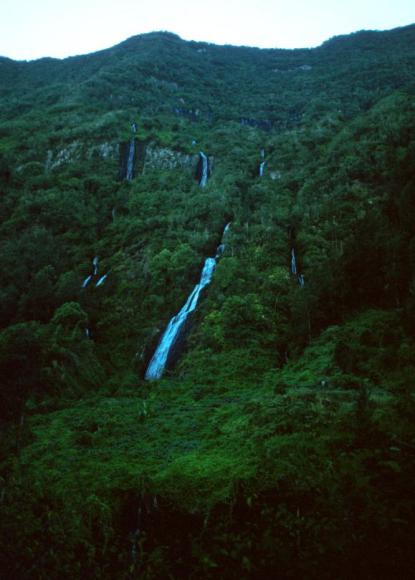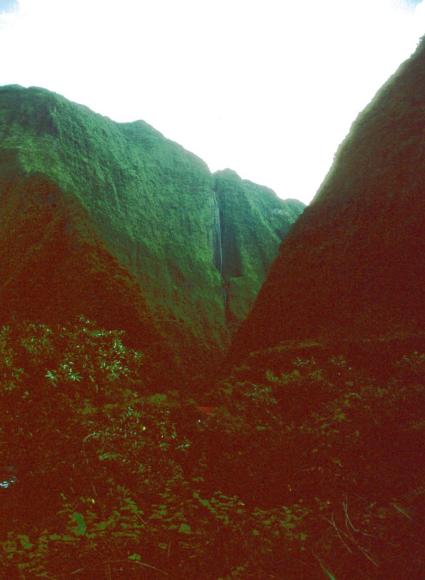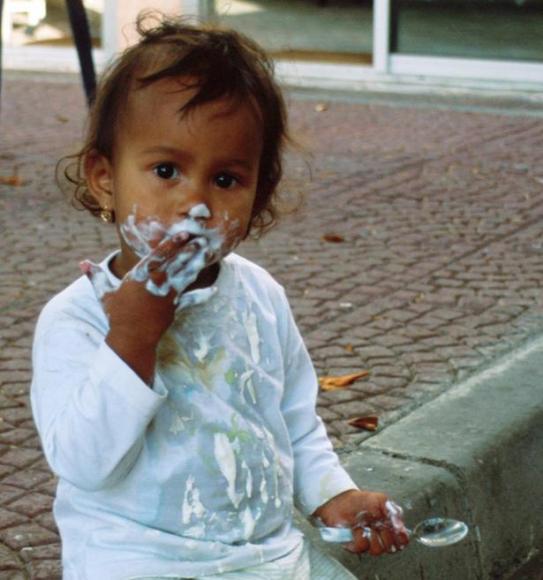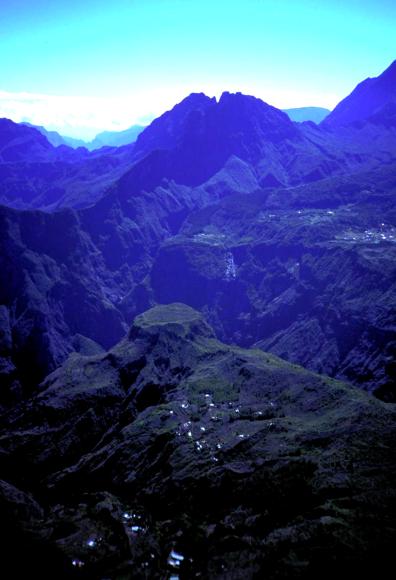
HISTORY
The Meeting counts with the last census of 1999, more than 700
000 inhabitants divided on this piece of lava lost in the Indian
Ocean. Its population is thus very significant, and will reach
by 2010-2015, the million hearts. However, whereas livable or
agricultural surface could start to miss, there are many places
in the island where the demographic density is so low that it
is lost in the majesty of great spaces. Mafate is one of them,
immense circus today still, only accessible to feet, crossed
ways and paths, virgin of asphalt roads.
Populated originally by slaves in escape who found finally an
area where their days were not threatened any more, joined more
late by the colonists, the zone is strewn with small villages
located on îlets, with the boxes often fixed on the ramparts,
masked by banana trees, ringed small enclosures, facts of chocas,
for the animals. It exists to reach it, several routes. One
of the most practised by the hikers is undoubtedly that of Maïdo,
by the road of collecting of the Orange trees to the Wood of
Medlars with Saint-Paul or even by the îlet of Lataniers
and the River of the Rollers. A fantastic tour offering a point
of considering incomparable on the whole of the circus.
The îlet of the Orange trees draws its name, for the simplest
version, of the fruit tree which one finds in abundance on the
plate since always. One second theory speaks about an orange
black, which it first would have occupied the places.
While waiting for, of all the districts, that of the Orange
trees was poorest a long time, that where the living conditions
were undoubtedly most difficult because of the lack of water.
Indeed, the few dwellings scattered with the liking of many
and deep gullies were located at one hour of walk of the source
nearest. Water was thus an invaluable good which had to be saved,
to preserve like most fabulous of the treasures.
At the time of colonization, certain families obtained concessions,
others not, but settled all the same, out the law, thinking
of being protected from the reprisals by the ramparts and insulation.
In 1874, the Forest Service wanted to drive out the inhabitants
of the circus in order to carry out its afforestation. No one
did not have the right then to burn a branch, even dead, under
penalty of seeing its destroyed dwelling or to be sent to dig
the port of the Point of the rollers. Exceeded, Mafatais managed
to drive out, with blow of stones and sticks, the foresters,
afterwards many years of sufferings. The îlet of Rock
Punt is as for him that which one sees of Maïdo. The district
was the first of the circus to being equipped with a school
and profits, contrary to the îlet of the Orange trees,
of an abundant irrigation. Guavas, bibasses, oranges, bananas,
fishings, vines belong to the resources of the village, at the
same time as the breeding, or the corn and bean culture. However,
these fifty last years, its population decreased considerably,
young people preferring the littoral in this center of the island.
Tourism however gave again life with the îlet and the
circus as a whole, which failed well to be deserted...
http://www.clicanoo.com/ciel/communes/mafate.htm
|

An Intense Island
In the midst of the Indian Ocean, a small French land is labouring
at shaking off all preconceived ideas about tropical islands.
Sure, there are coconut trees and beaches in Reunion, the
turquoise blue lagoons and the white barrier reef are there
waiting for you to fulfil your exotic dreams. Yet, these are
only a tiny part of the whole range of different things the
island offers travellers looking for unique experiences, encounters,
feelings and emotions. Here, Nature has left a heritage rich
in extraordinary scenery. Spread over 2500 square km, Reunion
has all the diversity a continent can offer. The island changes
her appearance with the relief and from abundance she can
suddenly become arid and from tropical, mountainous. She likes
astonishing you to better seduce you at every bend of her
sea coast or roads that hang onto the mountain. Also, in these
unique latitudes, history has concocted an exclusive cocktail
of people and cultures, with ingredients coming from Africa,
Asia and Europe. A harmonious mixture you'll discover with
your heart.
|
 |

D:\wwwupc\reunion\working\aindexpresent3.htm |
|
 |
The circus of Salazie, as of the origins
of colonization, constituted an ideal refuge for the maroon
blacks in escape which found there, a completely uninhabited
area and whose aspect enabled them to live hidden without
fearing to be taken again.
Indeed, the thick vegetation, the innumerable cashings, the
inaccessibility of certain pitons, constituted an inviolable
universe, where to seek a man summarized itself to find a
pinhead in the beautiful medium of a virgin forest. On the
littoral, the free grounds were done increasingly rare and
the mouths to be nourished increasingly many.
In 1829, a terrible cyclone fell down on the island and destroyed
the major part of harvests . The famished population thus
put in search new grounds and penetrated the circus gradually,
guided by the way opened by the hunters of kids which had
preceded it, from the very start of the XIXème century.
In 1830, the government which cannot face the economic disaster,
then encouraged the establishments of families inside the
circus, always without name, if it is not the Pond with water
Hens, first inhabited place. It is Annette Of the Serf, girl
of dealer who found the name of Salazie, inspired by the solid
mass of Salazes or of the Salaozy Madagascan who means "good
camping".
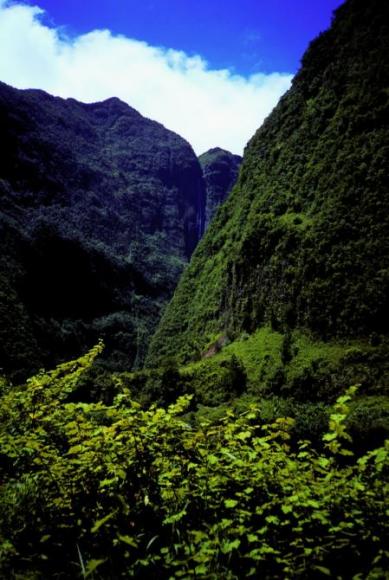
In 1834, some families gathered on a plate and created the
place known as of Small Sand Petit Sable, with the
site of the current village of Salazie... After having known
misery and the hunger outside the circus, the first inhabitants
found finally in Salazie, a hospital place where, thanks to
the richness of the grounds nourished permanently by the humus
of this vegetation luxuriante, all could push. Grains, vanilla,
vegetables in all kinds, rices, grapes, coffee, fishings,
lemons, apples, dreams, cresses, bananas, tobacco, pets or
christophines imported of Mexico in 1840 by Sully Brunet,
made it possible to the colonists to live in perfect autonomy,
without never depending on the resources of Saint-Andrew.
They went there besides only very seldom, the road connecting
the littoral remaining dangerous because of the many falls
and especially long, difficult to traverse. During this boom,
the straw pet held to with it a very significant place in
the life of Salaziens. It during more than one half-century
was used by manufacturing hats of the whole world which transfer
in it a material exceptional, remote, rare and expensive.
The cultures were forsaken with its profit, offering considerable
additional incomes, until the beginning of the XXème
century, when the passion for the cover-chiefs, new technologies,
replace it and ruin many families... Today, the village of
Salazie and its variations became high tourist places, hidden
under covers of incredible vegetations not stripping or little
the original vision.
The inhabitants live there at the rate/rhythm of the clouds,
the sunning and the rains, the flow of the "pisses in
the air", encircled by the majesty and the beauty of
the slopes precipice. Calms, serenity seem y to have found
the way of eternity, where few things change, where the magic
of the spectacle constitutes an inalienable law... "We
passed under the ombreux forks and spoons, the most splendid
trees, on a carpet of green foam and an emerald coat sown
of red cutters like rubies"... Auguste Vinsson.
http://www.clicanoo.com/ciel/communes/04_05_00.htm |
 |
|
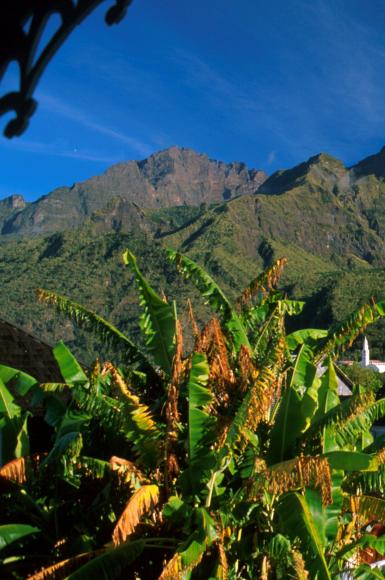
|








